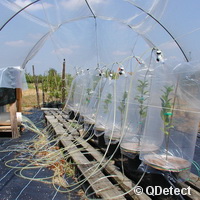Stopping the spread of ash dieback fungus
The destruction of trees as a result of the ash dieback fungus has been a growing concern among scientists, having seen its rapid spread across Europe since the 1990s. The fungus, which originated in Japan, emerged in Lithuania and Poland two decades ago, and moved swiftly across the continent, with 300 confirmed cases reported in the United Kingdom alone. But now scientists have just completed an EU-funded project to detect and monitor the quarantine plant pests, which were previously putting both European forestry and crop production at risk. Methods were devised under the three-year project entitled Q-DETECT, which stands for 'Developing quarantine pest detection methods for use by national plant protection organizations (NPPO) and inspection services'. The project was supported under the EU's 'Food, agriculture and fisheries, and biotechnology' (KBBE) programme to the tune of EUR 3 million. The main objective of the project was to heighten biosecurity efforts against invasive pests by developing a method based on a portable deoxyribonucleic acid (DNA) testing machine that can diagnose ash dieback within 30 minutes. Previously, scientists had to wait for days in order to obtain laboratory results. Tools developed by the Q-DETECT consortium now allow for detection of quarantine pests at, among others, airports and ports. The researchers also worked on devices that can 'hear' the larvae of the pests as they bore into the tree. In addition, satellite images can identify infested forests, as well as an 'electronic nose' able to detect infested potatoes in warehouses. Dr Neil Boonham from The Food and Environment Research Agency in the UK, who has been working on the project says, 'Acoustic and vibrometric methods were demonstrated to be a successful approach in detecting wood-boring insect larvae. One of the key outcomes was the development use of software that can identify which sounds come from wood-boring beetles and from the environment.' Although he points out, 'The system needs to be validated, to achieve this, and the partners are providing recording equipment to end users. This will encourage them to contribute to a library of analysed sounds, with which we can validate the software. Ultimately this may then be run as a service or released in another format so that end users can access the data.' In addition, 'Smelling volatiles from quarantine pests proved to be one of the most challenging approaches ,however great strides were taken in identifying potential compounds specific to pests and the use of the electronic nose to detect a wide range of different bacterial pathogens.' Future funding is now being sought by the consortium partners along with other partners for specific applications of volatile detection. Further work is also planned in remote imaging where the system will be trialled by the UK inspection service.For more information, please visit: Q-DETECT: http://www.qdetect.org
Countries
Switzerland, United Kingdom



